Some daily events in the changing sky for November 26 – December 4.
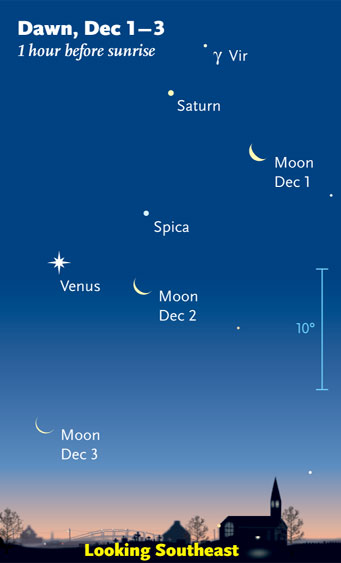
It's still pretty dark when a lot of people get up at this time of year. If that means you, look southeast in early dawn to see the waning Moon passing Saturn, Spica, and Venus day by day. The blue 10° scale is about the size of your fist held at arm's length. (For clarity, the Moon is shown three times actual size. These scenes are drawn for the middle of North America. European observers: move each Moon symbol a quarter of the way toward the one for the previous date.)
Sky & Telescope diagram
Friday, November 26
Saturday, November 27
Sunday, November 28
Monday, November 29
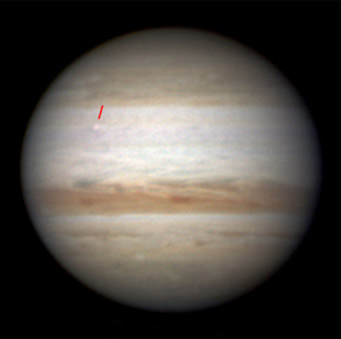
A new bright white spot (indicated) in the latitude of Jupiter 's South Equatorial Belt was the first sign of events that will probably lead to the whole belt's return. Discoverer Christopher Go took this image at 10:24 UT November 10th. Compare with the later images below. South is up.
Tuesday, November 30
Wednesday, December 1
Thursday, December 2
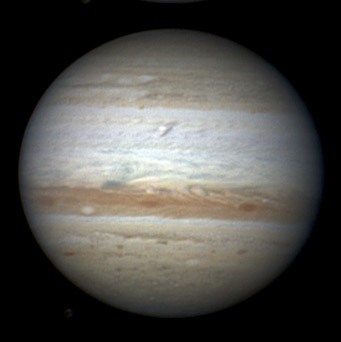
Just above center, the tiny new bright white spot in the latitude of Jupiter 's South Equatorial Belt had already grown a border of dark material by November 12th. Although the white spot doesn't look like much here, its brilliance in methane-band images revealed it to be a violent eruption driving cloud material unusually high into Jupiter's upper atmosphere. See our article Jupiter's Lost Belt Reviving?, and keep watch for yourself!
Christopher Go took this image at 11:17 UT November 12th, when the System II longitude on Jupiter's central meridian was 292°. South is up.
Friday, December 3
Saturday, December 4
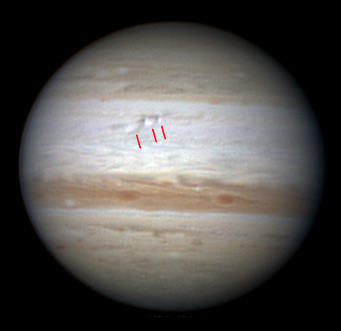
November 17th: Three outbreaks now, all in a row! Again, methane-band imagery confirms that the newest, smallest white spot is boiling up to a very high altitude, while the older two seem to be sinking back down. South is up.
Sky at a Glance is now an iPhone app! Put S&T SkyWeek on your iPhone, iPad, or iPod Touch and get the above listings anytime, anywhere — with interactive sky maps! Tap a button to see the scene described, customized for your location worldwide. From there you can scroll the view all around the sky, zoom in or out, change to any time or date, and turn on animation. Go to Apple's iTunes store from your device and buy S&T SkyWeek — just 99 cents!
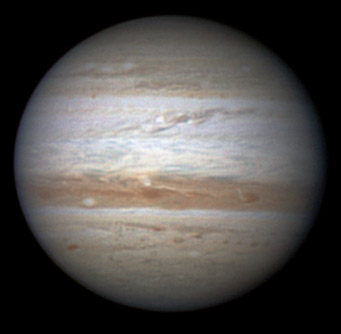
By November 24th, dark material was spreading far from the outbreak region.
Want to become a better amateur astronomer? Learn your way around the constellations. They're the key to locating everything fainter and deeper to hunt with binoculars or a telescope.
For an easy-to-use constellation guide covering the whole evening sky, use the big monthly map in the center of each issue of Sky & Telescope, the essential magazine of astronomy. Or download our free Getting Started in Astronomy booklet (which only has bimonthly maps).
Once you get a telescope, to put it to good use you must have a detailed, large-scale sky atlas (set of charts). The standards are the Pocket Sky Atlas, which shows stars to magnitude 7.6; the larger Sky Atlas 2000.0 (stars to magnitude 8.5); and the even larger and deeper Uranometria 2000.0 (stars to magnitude 9.75). And read how to use your charts effectively.
You'll also want a good deep-sky guidebook, such as Sky Atlas 2000.0 Companion by Strong and Sinnott, or the more detailed and descriptive Night Sky Observer's Guide by Kepple and Sanner, or the classic if dated Burnham's Celestial Handbook.
This Week's Planet Roundup
Mercury (magnitude –0.4) is now in the best week of its current evening apparition, but it's still quite low. Look for it in mid-twilight above the southwest horizon.
Venus is at its maximum brightness (magnitude –4.9!) as the "Morning Star" before and during dawn, in the southeast. Look for much fainter Spica to Venus's upper right, and for Saturn above Spica.
Mars (magnitude +1.3) is nearly lost in bright twilight. Use binoculars to look for it to the right or lower right of brighter Mercury. Good luck.
Jupiter (magnitude –2.6, at the Pisces-Aquarius border) shines high in the south to southwest during evening, the brightest starlike point in the sky. In a telescope it's still 43 arcseconds wide. Jupiter's missing South Equatorial Belt is finally starting to re-form, as dark material spreads from a series of telltale bright storm spots that appeared three weeks ago. See our article Jupiter's Lost Belt Reviving?. The outbreak zone transits Jupiter's central meridian about 3 hours and 40 minutes after the Great Red Spot.
As for the Great Red Spot, it's near System II longitude 157°. Assuming it stays there, here's a list to print out of all the Great Red Spot's predicted transit times for the rest of this observing season.
Saturn (magnitude +0.9, in Virgo) glows in the east-southeast before and during dawn, about 16° upper right of bright Venus. The best time to observe Saturn with a telescope is during early dawn, when the planet will be less blurred by low-altitude atmospheric turbulence. Saturn's rings have widened to 9° or 10° from edge-on.
Uranus (magnitude 5.8) is 3° east of Jupiter.
Neptune (magnitude 7.9, in Capricornus) is still high in the south-southwest right after dark. See our finder charts for Uranus and Neptune online or, with article, in the September Sky & Telescope, page 56. Can you see any color in Uranus and/or Neptune?
Pluto (magnitude 14.0, in Sagittarius) is lost in the sunset.
All descriptions that relate to your horizon — including the words up, down, right, and left — are written for the world's mid-northern latitudes. Descriptions that also depend on longitude (mainly Moon positions) are for North America. Eastern Daylight Time (EDT) equals Universal Time (also known as UT, UTC, or GMT) minus 4 hours.
To be sure to get the current Sky at a Glance, bookmark this URL:
http://SkyandTelescope.com/observing/ataglance?1=1
If pictures fail to load, refresh the page. If they still fail to load, change the 1 at the end of the URL to any other character and try again.
 0
0
Comments
You must be logged in to post a comment.